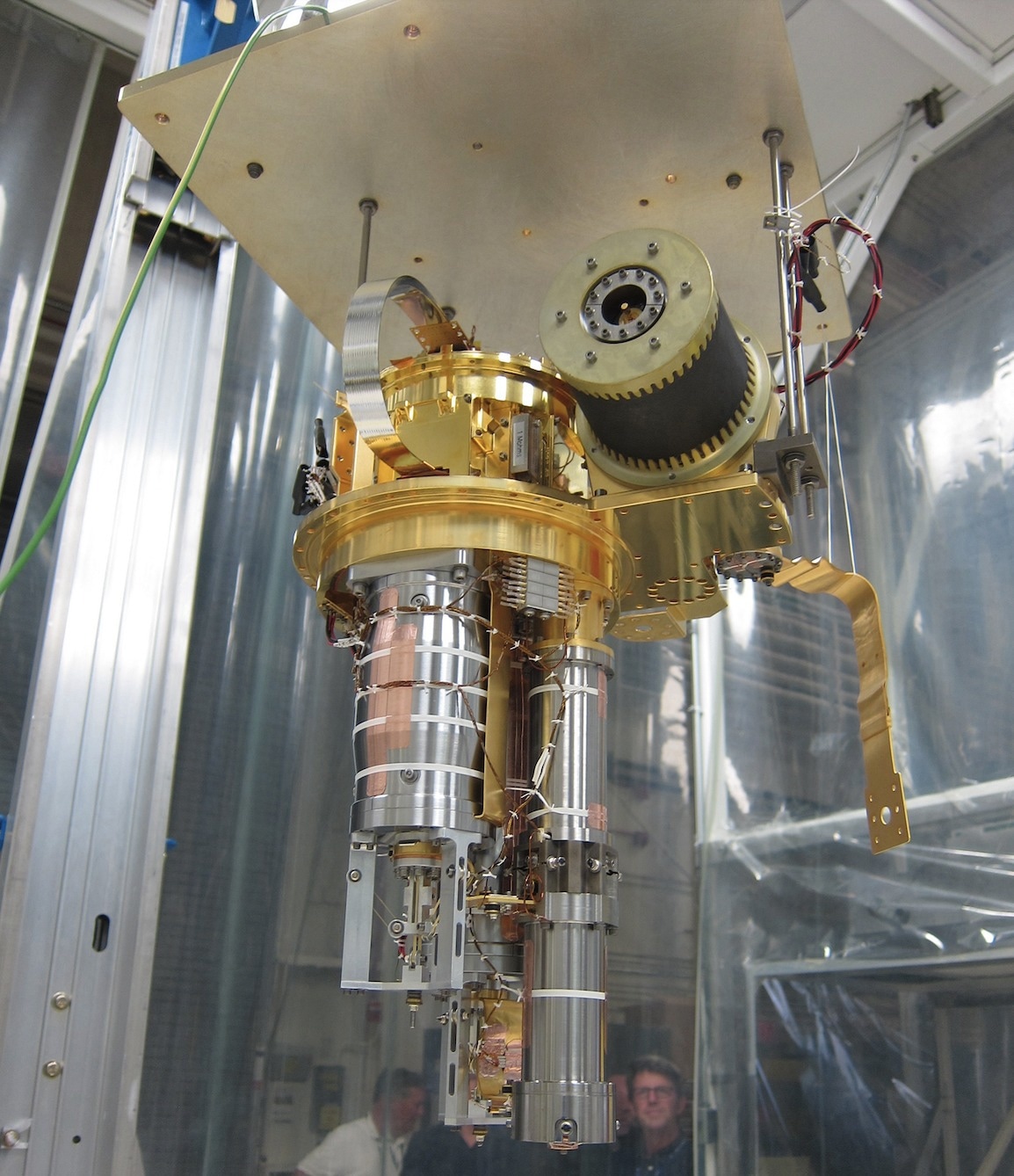XRISM (X-Ray Imaging and Spectroscopy Mission) is known to be a powerful satellite that is all set to offer astronomers a radical look at the X-Ray sky.
 XRISM’s Resolve CSI (Calorimeter Spectrometer Insert) prepares for testing at Goddard in July 2019 in this photo. The CSI allows X-ray light focused by the X-ray mirrors at the front of the spacecraft to reach the Resolve detector. The hardware here includes the sensitive detector assembly in addition to the cooling system that, together with the JAXA dewar, can achieve the cold temperatures required to enable XRISM science. Image Credit: NASA
XRISM’s Resolve CSI (Calorimeter Spectrometer Insert) prepares for testing at Goddard in July 2019 in this photo. The CSI allows X-ray light focused by the X-ray mirrors at the front of the spacecraft to reach the Resolve detector. The hardware here includes the sensitive detector assembly in addition to the cooling system that, together with the JAXA dewar, can achieve the cold temperatures required to enable XRISM science. Image Credit: NASA
XRISM, headed by JAXA (Japan Aerospace Exploration Agency) in partnership with NASA and with contributions from ESA (European Space Agency), has been planned to launch on an H-IIA rocket from Japan’s Tanegashima Space Center at 8:26 p.m. EDT on Sunday, August 27th, 2023 (9:26 AM on Monday, August 28th, 2023 in Japan).
JAXA will be streaming the launch live on YouTube, along with a broadcast in both English and Japanese starting at 7:55 PM EDT.
Some of the things we hope to study with XRISM include the aftermath of stellar explosions and near-light-speed particle jets launched by supermassive black holes in the centers of galaxies. But of course, we’re most excited about all the unexpected phenomena XRISM will discover as it observes our cosmos.
Richard Kelley, XRISM Principal Investigator, Goddard Space Flight Center, National Aeronautics and Space Administration
Also, on this launch is JAXA’s SLIM (Smart Lander for Investigating Moon), which has been developed to illustrate precise, “pinpoint” lunar landing methods by a small explorer. NASA offered a laser retroreflector array for SLIM, as both agencies collaborate in the international effort to additionally explore the Moon and, eventually, human exploration of Mars.
XRISM helps detect X-Rays with energies varying from 400 to 12,000 electron volts. (For comparison, the energy of visible light ranges from 2 to 3 electron volts.)
This range will offer astrophysicists new data regarding a few of the universe’s largest structures, hottest regions, and objects with the strongest gravity.
The mission consists of two instruments, Xtend and Resolve.
Resolve is known as a microcalorimeter spectrometer that has been developed in partnership between NASA and JAXA. When an X-Ray hits Resolve’s 6-by-6-pixel detector, its energy leads to a small increase in temperature.
By quantifying every individual X-Ray energy, the instrument offers information regarding the source, like its motion, composition, and physical state.
For such tiny temperature changes to be detected, Resolve should function at just a fraction of a degree above absolute zero. It attains this state in orbit following a multistage mechanical cooling process within a refrigerator-sized container of liquid helium.
Resolve leverages technologies developed for previous X-ray missions like Suzaku and Hitomi. It represents the culmination of years of collaborative work between JAXA, NASA, and other partners from around the globe.
Lillian Reichenthal, XRISM Project Manager, Goddard Space Flight Center, National Aeronautics and Space Administration
XRISM’s second instrument, named Xtend, was made by JAXA. It will provide XRISM with one of the biggest fields of view of any X-Ray imaging satellite flown to date, thereby noting an area approximately 60% larger compared to the average apparent size of the full moon. The images it gathers will complement the data that has been collected by Resolve.
Every instrument is at the focus of an XMA (X-Ray Mirror Assembly) that has been designed and developed at Goddard.
X-Ray wavelengths are so brief that they could pass straight between the atoms of the dish-shaped mirrors that have been utilized to capture infrared, visible, and ultraviolet light.
Rather, X-Ray astronomers make use of nested curved mirrors turned on their sides. The X-Rays run away from the surfaces, similar to stones across a pond and into the detectors.
Each of XRISM’s XMAs dwells hundreds of concentric, accurately shaped aluminum shells constructed in quadrants and arranged into a circle. There are more than 3,200 individual mirror segments in the two mirror assemblies.
Following the launch, XRISM will start a months-long calibration phase, during which Resolve will reach its operating temperature.
Once XRISM begins collecting data, scientists will have the opportunity to propose sources for the mission to study. Researchers from around the world will have access to the cutting-edge work XRISM will be doing.
Mihoko Yukita, Astrophysicist, Goddard and Johns Hopkins University
Yukita works for NASA’s Guest Observer Facility for XRISM.
XRISM Exploring the Hidden X-ray Cosmos
Watch this video to learn more about XRISM (X-ray Imaging and Spectroscopy Mission), a collaboration between JAXA (Japan Aerospace Exploration Agency) and NASA. Image Credit: NASA’s Goddard Space Flight Center